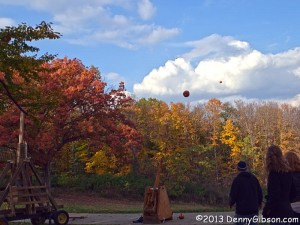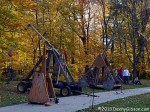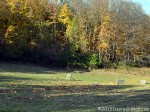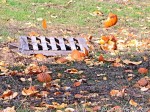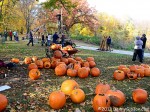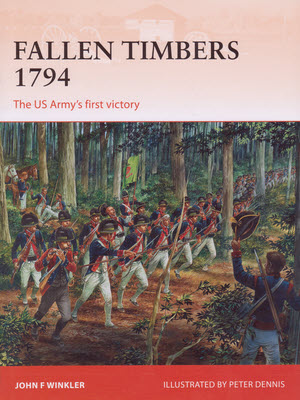 Everyone loves a winner and, in 1794, the United States Army finally became one. In his earlier work, Wabash 1791, Winkler tells of the new nation’s first military campaign and the disaster that resulted. Fallen Timbers 1794, describes the campaign that led to a victory at Fallen Timbers and ultimately to the Treaty of Greenville.
Everyone loves a winner and, in 1794, the United States Army finally became one. In his earlier work, Wabash 1791, Winkler tells of the new nation’s first military campaign and the disaster that resulted. Fallen Timbers 1794, describes the campaign that led to a victory at Fallen Timbers and ultimately to the Treaty of Greenville.
The 1791 Battle of the Wabash, more commonly known as St Clair’s Defeat, essentially destroyed the United States Army. In 1792, congress created a new one. To lead this new army, The Legion of the United States of America, President Washington chose Revolutionary War veteran Anthony Wayne. Wayne did things quite a bit differently than did St Clair. He made sure his troops were trained and equipped before setting out and he placed a series of defensible forts so as to protect his supply line. Perhaps more importantly, he understood the Indian methods of combat and devised tactics to counter them. Like St Clair, Wayne had difficulties with supplies and contractors but it seems that now it was not only greed and incompetence that fueled them but an actual conspiracy aimed at causing his failure.
As he did in Wabash 1791, Winkler sets the scene for the campaign by describing the “strategic situation” and with chapters on the opposing commanders, armies, and plans. In many respects, the world situation was still much like it was in 1791. The United States was only a few years older and only a tiny bit more stable. Britain’s support and encouragement of the natives may have actually increased and neither France not Spain had vanished from North America. In fact, French elements were very much at play, often for the worse, inside the young nation. Of course, there were also plenty of homegrown problems. That previously mentioned conspiracy was one of them and, in the westernmost reaches, open revolt was a real possibility. These were the days of the Whiskey Rebellion. Less than three weeks before the Battle of Fallen Timbers, a crowd of 7,000 threatened to march on Pittsburgh. It was less than two months after the battle that President Washington personally went into the field to put down the uprising.
Three dimensional maps, like those that helped in understanding the Battle of Wabash, do the same for the Battle of Fallen Timbers. Other maps, along with period portraits and modern photographs, help understand the people and places involved. Peter Dennis’ wonderful paintings, one of which is used for the cover, provide realistic visualizations of specific battle scenes.
Winkler’s book on the Battle of the Wabash had nowhere near the shortcomings of the battle it described but he did manage to improve on it a little with Fallen Timbers 1794. I resorted to the word “scholarly” in describing the front end of Wabash 1791. It was justified, I offered, because it presented a lot of information that made later portions of the book flow more smoothly. But in this latest book, I never did get the feeling of slogging through mounds of dry facts that I had before. I have no way to quantify this and it may be simply that less preliminary facts are required or that they are less dry or that I am better prepared. Any or all of those could be true but my gut feel is that Winkler has refined his language and maybe even the structure to produce something more easily read.
During the last few years, any time that the average person felt like devoting to history was spent, more than likely, on the Civil War sesquicentennial. I have absolutely no disagreement with that but still thought it nice that, here and there, the bicentennial of the War of 1812 got some attention. The territory in dispute in 1812 was not all that different than what was being fought over in 1791 and 1794. Some of the nations and even some of the individuals involved were the very same. To the War of 1812 and especially to the Battle of the Thames, the battles at Wabash and Fallen Timbers were “prequels”.
Fallen Timbers 1794: The US Army’s first victory, John F Winkler, Osprey Publishing, February 2013, paperback, 9.8 x 7.2 inches, 96 pages, ISBN 978-1780963754
Available through Amazon.
 On Friday, November 22, 2013, a friend and I visited the National Museum of the US Air Force near Dayton, Ohio. Among the many historic items on display is the Boeing VC-137C that carried John F Kennedy to and from Dallas, Texas. The two pictures below were taken of the same general area of the plane just a few hours shy of fifty years apart.
On Friday, November 22, 2013, a friend and I visited the National Museum of the US Air Force near Dayton, Ohio. Among the many historic items on display is the Boeing VC-137C that carried John F Kennedy to and from Dallas, Texas. The two pictures below were taken of the same general area of the plane just a few hours shy of fifty years apart.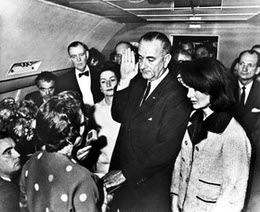
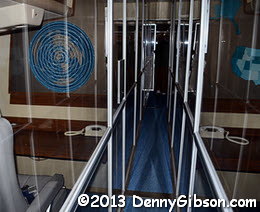

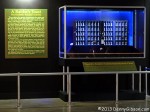 Another museum display recently in the news is associated with the Doolittle Raiders. A “Last Man Standing” pact had been established in which the last surviving Raider would drink a toast to all those who had gone before him.On the most recent anniversary of their 1942 bombing run over Toyko, the last four living Raiders decided not to wait but to have their final public reunion and drink their toast now. That toast took place at the museum on November 9 and can be seen here. Their eighty silver goblets, with the seventy-six belonging to diseased Raiders standing up side down, are displayed at the museum. My report on last year’s 70th reunion is here.
Another museum display recently in the news is associated with the Doolittle Raiders. A “Last Man Standing” pact had been established in which the last surviving Raider would drink a toast to all those who had gone before him.On the most recent anniversary of their 1942 bombing run over Toyko, the last four living Raiders decided not to wait but to have their final public reunion and drink their toast now. That toast took place at the museum on November 9 and can be seen here. Their eighty silver goblets, with the seventy-six belonging to diseased Raiders standing up side down, are displayed at the museum. My report on last year’s 70th reunion is here.
 On this day fifty years ago I was a high school junior. I do not even remember most of the day and some that I do remember is foggy and questionable. I remember some very small pieces all too well. I remember going to my chemistry class and taking a seat in the second or third row. It was the rightmost seat facing the teacher’s desk and the wall of blackboards. My memory is that the principal, Mr Pawlowski, entered before class actually started and gave us the news though it might have come from Mr Conrad, the instructor. In my memory, Mr Pawlowski quickly moved on to personally deliver his message in other classrooms so that every student heard the same version. It is logical and might indicate how important he thought the message — and its uniform delivery — was but I cannot be certain that my memory is accurate. The message was, of course, “The President has been shot.”
On this day fifty years ago I was a high school junior. I do not even remember most of the day and some that I do remember is foggy and questionable. I remember some very small pieces all too well. I remember going to my chemistry class and taking a seat in the second or third row. It was the rightmost seat facing the teacher’s desk and the wall of blackboards. My memory is that the principal, Mr Pawlowski, entered before class actually started and gave us the news though it might have come from Mr Conrad, the instructor. In my memory, Mr Pawlowski quickly moved on to personally deliver his message in other classrooms so that every student heard the same version. It is logical and might indicate how important he thought the message — and its uniform delivery — was but I cannot be certain that my memory is accurate. The message was, of course, “The President has been shot.”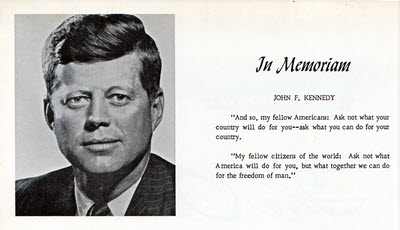 President John F Kennedy was officially pronounced dead at 1:00 PM CST; The same time as the posting of this article. The scan at left is of an introductory page of my high school’s 1964 yearbook. I imagine something similar appeared in the yearbooks of thousands of schools across the country. I believe the picture is a closely cropped version, with the background removed, of the official one at the beginning of this article.
President John F Kennedy was officially pronounced dead at 1:00 PM CST; The same time as the posting of this article. The scan at left is of an introductory page of my high school’s 1964 yearbook. I imagine something similar appeared in the yearbooks of thousands of schools across the country. I believe the picture is a closely cropped version, with the background removed, of the official one at the beginning of this article. Everyone loves a winner and, in 1794, the United States Army finally became one. In his earlier work,
Everyone loves a winner and, in 1794, the United States Army finally became one. In his earlier work, 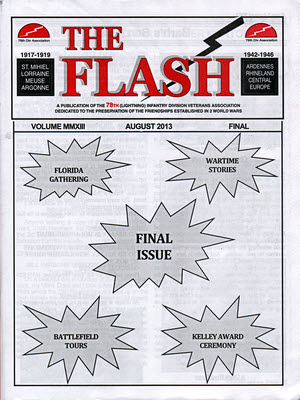 This Flash is not a fleet-footed tights-wearing superhero. It is, or was, a publication, though saying it was about superheroes would not be wrong. The Flash‘s banner reads “A publication of the 78th (Lightning) Infantry Division Veterans Association dedicated to the preservation of the friendships established in 2 world wars”. The association is disbanding. There just aren’t that many friendships to preserve anymore.
This Flash is not a fleet-footed tights-wearing superhero. It is, or was, a publication, though saying it was about superheroes would not be wrong. The Flash‘s banner reads “A publication of the 78th (Lightning) Infantry Division Veterans Association dedicated to the preservation of the friendships established in 2 world wars”. The association is disbanding. There just aren’t that many friendships to preserve anymore. The
The 



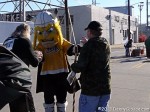
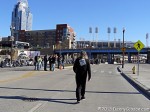
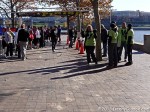
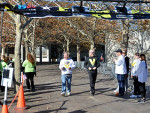
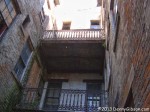
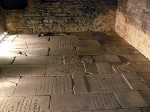

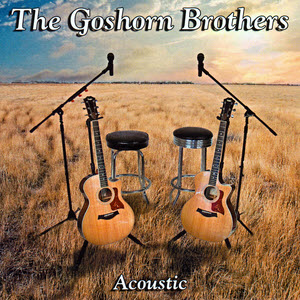 I thought I might never get this posted but I did it and it’s not even a year late. It’s close, though. The official release of Acoustic, which coincided with
I thought I might never get this posted but I did it and it’s not even a year late. It’s close, though. The official release of Acoustic, which coincided with 